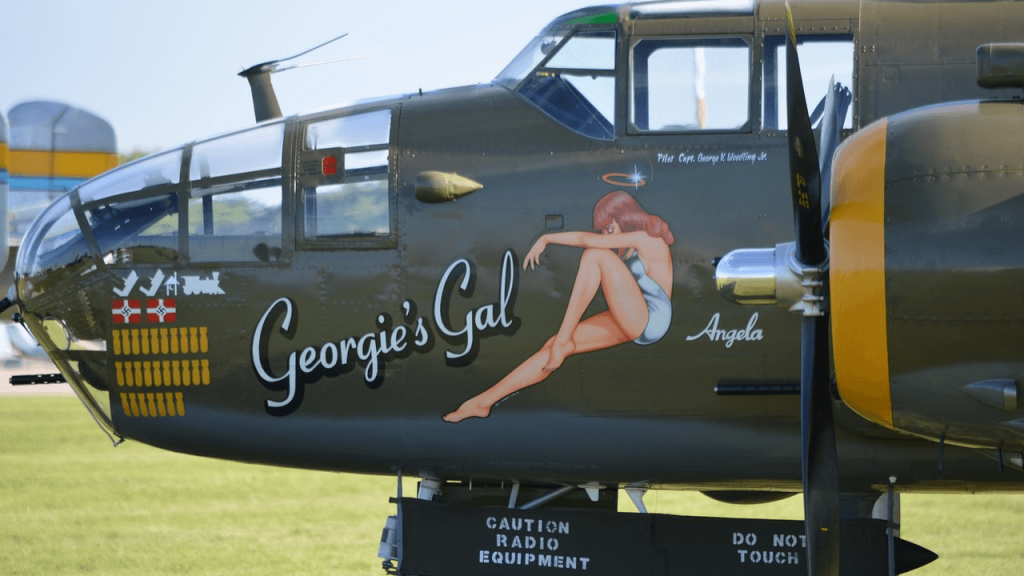
The timeless sexy image of pin-up girls, with their seductive yet tasteful poses, has captivated audiences for generations. Often portrayed in artwork and photography, these glamorous women have left a significant mark on popular culture.
One intriguing aspect of pin-up girls’ history is their association with aircraft, particularly during the World War II era when they were painted on planes to boost morale.
However, it’s crucial to address a prevalent misconception surrounding pin-up girls – their wrongful connection to the porn industry.
While it’s true that some modern porn sites like lupo porn may have categories labeled as “pin-up girls,” it is essential to distinguish between these explicit depictions and the traditional pin-up girl art form that graced the sides of aircraft during wartime.
The traditional pin-up girl, as depicted on planes, was characterized by tasteful and artistic representations.
These paintings showcased women in playful, flirty poses, designed to uplift spirits and foster camaraderie among the troops, rather than exploiting explicit content for arousal.
Unfortunately, the modern misinterpretation of pin-up girls has led to unwarranted assumptions about their historical significance and their portrayal during certain historical periods.
In this article, we will delve into the historical significance and reasons behind this fascinating practice, exploring its cultural, social, and motivational aspects that inspired generations of artists and pilots alike.
The Historical Context: Origins and Popularity during World War II
The tradition of painting pin-up girls on planes dates back to the early 20th century. However, it gained widespread popularity and significance during World War II. As soldiers were stationed far away from home, aircraft became their primary link to the outside world.
The act of decorating the planes with these alluring depictions of women was believed to have started as a morale-boosting measure. The pin-up girls represented a connection to their loved ones, providing a sense of comfort and familiarity amid the chaos of war.
Pin-Up Girls and Their Connection to the Porn Industry
It is crucial to acknowledge that the association between pin-up girls and the porn industry existed to some extent. In the past, some of these images were undoubtedly produced with explicit intentions and were used inappropriately.
However, it is essential to differentiate between the artistic tradition of pin-up girls and the exploitation of women in pornography. The pin-up girl art form, when appreciated in its proper context, is about celebrating beauty, aesthetics, and artistic expression.
The Theories and Reasons Behind Using Pin-Up Girls on Planes
Morale-Boosting: As mentioned earlier, one of the primary reasons for painting pin-up girls on planes was to boost the morale of soldiers.
The images served as a reminder of the world they left behind and the loved ones they were fighting to protect.
Identification and Personalization: In the vast expanse of the battlefield, identifying and differentiating one aircraft from another was essential. By adorning planes with unique and eye-catching pin-up girl paintings, crews could easily recognize their aircraft.
Superstitions and Luck: Many pilots and crew members believed that having a pin-up girl on their aircraft would bring them luck and help ensure a safe return from their missions.
Inspiration and Motivation: Pin-up girl paintings were not limited to aircraft; they were also found in barracks and mess halls. The images of confident and beautiful women served as a source of inspiration, reminding soldiers of the home they were fighting to protect.
Artists and Illustrators Who Contributed to the Pin-Up Girl Tradition
Numerous talented artists and illustrators made significant contributions to the pin-up girl art form.
Among the most notable names was Alberto Vargas, whose iconic Vargas Girls became synonymous with the pin-up culture.
Other artists like Gil Elvgren, George Petty, and Earl Moran also left an indelible mark on the tradition with their masterful depictions of pin-up girls.
These artists not only shaped the aesthetic of the pin-up girl but also influenced the broader world of art and advertising.
Evolution of Pin-Up Girls: Adapting to Changing Social Norms«
As social norms and perceptions evolved over time, so did the portrayal of pin-up girls. Initially, the images tended to be more modest, reflecting the conservative values of the time.
However, as the decades progressed, the depictions became more daring and liberated, mirroring the changing attitudes towards sexuality and femininity.
Controversies and Criticisms
While the tradition of painting pin-up girls on planes was widely embraced during its heyday, it did not escape criticism. Some argued that the practice objectified women, reducing them to mere symbols of desire.
Additionally, some considered the paintings to be inappropriate and offensive, especially when considering the diverse backgrounds and beliefs of the soldiers serving in the military.
Conclusion: The Enduring Legacy of Pin-Up Girls on Planes
Despite the controversies and changing social norms, the tradition of painting pin-up girls on planes remains an intriguing and historically significant aspect of aviation history.
These artworks provided comfort, inspiration, and a touch of home to soldiers during times of adversity.
While we acknowledge the flaws in its association with the porn industry and potential objectification of women, the artistic aspect of the pin-up girl tradition should be celebrated for its enduring impact on popular culture, art, and the morale of those who served in the armed forces.
In today’s world, these iconic pin-up girl paintings stand as reminders of a bygone era and serve as a testament to the resilience of those who fought for their countries.
As we reflect on the past, let us appreciate the artistry and the cultural significance of these images while also recognizing the importance of fostering a more inclusive and respectful representation of women in all forms of art and media.